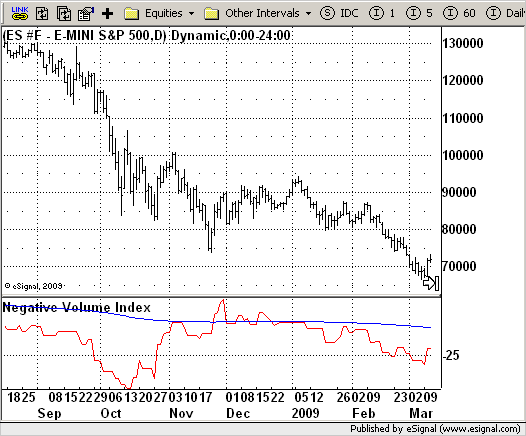File Name: NVI_Peterson.efs
Description:
Negative Volume Index
Formula Parameters:
EMA_Len : 255
Notes:
The theory behind the indexes is as follows: On days of increasing
volume, you can expect prices to increase, and on days of decreasing
volume, you can expect prices to decrease. This goes with the idea of
the market being in-gear and out-of-gear. Both PVI and NVI work in similar
fashions: Both are a running cumulative of values, which means you either
keep adding or subtracting price rate of change each day to the previous day`s
sum. In the case of PVI, if today`s volume is less than yesterday`s, don`t add
anything; if today`s volume is greater, then add today`s price rate of change.
For NVI, add today`s price rate of change only if today`s volume is less than
yesterday`s.
Download File:
NVI_Peterson.efs

EFS Code:
Description:
Negative Volume Index
Formula Parameters:
EMA_Len : 255
Notes:
The theory behind the indexes is as follows: On days of increasing
volume, you can expect prices to increase, and on days of decreasing
volume, you can expect prices to decrease. This goes with the idea of
the market being in-gear and out-of-gear. Both PVI and NVI work in similar
fashions: Both are a running cumulative of values, which means you either
keep adding or subtracting price rate of change each day to the previous day`s
sum. In the case of PVI, if today`s volume is less than yesterday`s, don`t add
anything; if today`s volume is greater, then add today`s price rate of change.
For NVI, add today`s price rate of change only if today`s volume is less than
yesterday`s.
Download File:
NVI_Peterson.efs

EFS Code:
PHP Code:
/*********************************
Provided By:
eSignal (Copyright c eSignal), a division of Interactive Data
Corporation. 2009. All rights reserved. This sample eSignal
Formula Script (EFS) is for educational purposes only and may be
modified and saved under a new file name. eSignal is not responsible
for the functionality once modified. eSignal reserves the right
to modify and overwrite this EFS file with each new release.
Description:
Negative Volume Index
Version: 2.0 05/28/2009
Formula Parameters: Default:
EMA_Len 255
Notes:
The theory behind the indexes is as follows: On days of increasing
volume, you can expect prices to increase, and on days of decreasing
volume, you can expect prices to decrease. This goes with the idea of
the market being in-gear and out-of-gear. Both PVI and NVI work in similar
fashions: Both are a running cumulative of values, which means you either
keep adding or subtracting price rate of change each day to the previous day`s
sum. In the case of PVI, if today`s volume is less than yesterday`s, don`t add
anything; if today`s volume is greater, then add today`s price rate of change.
For NVI, add today`s price rate of change only if today`s volume is less than
yesterday`s.
**********************************/
var fpArray = new Array();
var bInit = false;
function preMain(){
setStudyTitle("Negative Volume Index");
setCursorLabelName("NVI",0);
setDefaultBarFgColor(Color.red,0);
setCursorLabelName("EMA",1);
setDefaultBarFgColor(Color.blue,1);
var x = 0;
fpArray[x] = new FunctionParameter("EMA_Len", FunctionParameter.NUMBER);
with(fpArray[x++]) {
setLowerLimit(1);
setDefault(255);
}
}
var xNVI = null;
var xNVI_EMA = null;
function main(EMA_Len) {
var nBarState = getBarState();
var nNVI = 0;
var nEMA = 0;
if (nBarState == BARSTATE_ALLBARS) {
if(EMA_Len == null) EMA_Len = 255;
}
if (bInit == false) {
xNVI = efsInternal("Calc_NVI");
xNVI_EMA = ema(EMA_Len, xNVI);
bInit = true;
}
nNVI = xNVI.getValue(0);
nEMA = xNVI_EMA.getValue(0);
if (nEMA == null) return;
return new Array(nNVI, nEMA);
}
var bSecondInit = false;
var xROC = null;
var xVolume = null;
function Calc_NVI() {
var nRes = 0;
var nRef = ref(-1);
if (bSecondInit == false) {
xROC = roc(1);
xVolume = volume();
bSecondInit = true;
}
if (xROC.getValue(-1) == null) return;
if(xVolume.getValue(0) < xVolume.getValue(-1)) {
nRes = nRef + xROC.getValue(0);
} else {
nRes = nRef;
}
return nRes;
}